Today I saw something I had never seen before. A coyote captured a gopher by patiently and quietly waiting for it, then dove in after it, head first. The gopher was not immediately killed, which made it very difficult for me to watch. In fact, the little animal always landed on its feet when it was dropped: it looked like it was putting up a fight or was pleading for mercy. Eventually it was still, and the predator carried its dead prey a distance — maybe 200 yards — and dropped it. And this is the part I have never seen before: the coyote then scooped out a hole with its muzzle, moved the gopher into the hole, then used its muzzle to move dirt and leaves over the animal: it was being buried. The process took less than 60 seconds. I’m wondering if coyotes have “caches” of food here and there? I looked at the site when the coyote left — although there was a little mound of leaves, it really was hard telling it apart from the area around it. I went back a day later to find that the leaves and the deceased were still in place. But I looked again on October 30th, three days after the kill, and although the leaves and sticks were carefully piled back where they had been, the gopher was no longer there. So maybe it had been “saved” for later? Coyotes eat not only prey, but also carrion. I have seen a coyote bury an old, dead, dry snake. Also, there has been an observation of a coyote burying a rock!!
I love watching and documenting coyote behavior. I’ve seen a mother coyote dart down a hill to aid her pup who was being chased by a dog: then both coyotes, mother and pup, “worked” the dog, charging it from both sides and nipping the haunches, as a cattle dog would, to get it to move on. The dog obviously was overwhelmed and fled with his tail between his legs. Today I watched a bored coyote, at rest, gnaw on a branch which was within its resting reach — the coyote seemed to be entertaining itself. I’ve seen a sitting coyote grab a gopher out of a hole as effortlessly as we might grab a coke from the refrigerator. And I’ve seen a coyote really work for its meal: standing, head cocked to one side, and waiting patiently at a vole or gopher hole until there was movement, and then dive, muzzle first, with a high leap, into the hole, where, if the coyote wasn’t able to grab the critter, at least he had injured it, because with a little digging, the injured vole/gopher was retrieved. Prey is sometimes killed and consumed right off — with minimal chewing or bone crunching followed by one big gulp, and sometimes it is toyed with. Besides voles and gophers, I’ve seen coyotes eat peanuts and catch a squirrel. And I’ve seen a coyote eat grass, exactly the same as some dogs do, and then heave several times to throw it up. Coyotes have been seen devouring snails.
A couple of times I have seen coyotes catch voles, toy with them and eventually behead them (coyotes’ back teeth are like scissors), before tossing the carcass aside never to be eaten. I wonder why? And in back of a house I once saw a couple of dead voles which I thought might have been poisoned (rat poisoning from the house?), because when, a few days later, a coyote came upon them, she picked one up in her mouth, she spat it out disgustedly, and then squatted over them and urinated on them. Might this be some sort of sign to other coyotes?
I’ve seen coyotes, sometimes alone and sometimes in twos, go up to a known dog with its owner close by, circle around and, ultimately, as if it were a dare, go up and “touch” the tail of the dog before running off. I’ve seen coyotes sit for hours, watching the show of walkers and dogs in a park — calm, collected and relaxed — until a dog gave chase. I’ve noticed that each coyote has a very different “critical distance” that they like to maintain from walker and dog to walker and dog. Coyotes seem to ignore humans and never approach them, but coyotes are keenly interested in all dogs and can “size them up” as to their friendliness, aggressiveness, dominance, energy. And, coyotes seem to know when dogs are leashed.
And human behavior is just as interesting. When a coyote is close to the trail I always let people know that it might be best to leash up – after all, the parks are “on-leash” parks, even though few people abide by this. Today, a fellow human balked when I suggested that giving the coyote a wide berth might keep things calm. Oh no — for this man, coexistence means the coyote would have to move. So I watched as this fellow and his dog went by, obviously within the coyote’s “critical distance”. Although the coyote kept its distance, it began baring its teeth and wrinkling its nose, charging back and forth in short spurts, scratching the soil and bucking and rearing — the coyote was obviously upset. So the man pulled his dog along and hurried by. Is it really so difficult to give in a little to the wildlife in our parks? This female coyote did end up moving off — but I don’t think she would have during pupping season: May to September.
The first four photos above show the capture, fighting back and burial of a gopher. Photo five is of a coyote playing with a stick. The last photo shows how upset a coyote is when the above-mentioned dog walker entered the coyote’s critical space — the walker could easily have given the coyote a wider berth.

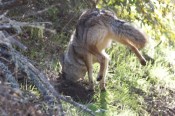
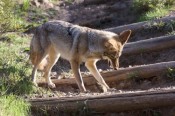
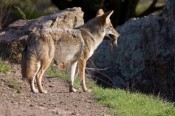
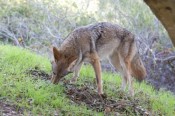
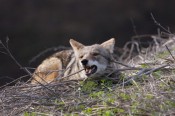
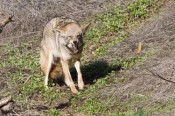


Mar 24, 2020 @ 17:51:43
I live in North Phoenix. Yesterday in the early afternoon I was told a coyote entered under the gate of my community attacked and killed my cat. It then took her body behind another neighbors home and dug thru rocks to bury it. Her body was recovered by my roommate. I read your story on how they bury animals. I live in a very populated area with small animals and children. Is there a possibility the animal will come back? My concern is for the community I live in. I drove thru the community and say a pair coyotes a few months back but never heard of any killing of pets.
Mar 24, 2020 @ 23:40:08
Hi Marleah,
Yes, there is a possibility the coyote will come back. Coyotes don’t discriminate between small pets or any other small animals they might see as prey. How could they possibly know the difference? So it’s up to us to always supervise our pets out-of-doors by being with them. When walking a dog, always walk away from them, and pick up a very small pet as you walk away. Coyotes have lived here in San Francisco for over 18 years: coexistence is not at all difficult, but it does require that you do a few things, such as keep away from them and don’t allow dogs to chase them. Know that coyotes are small animals, weighing between 20 and 35 pounds. All you need to do is walk away from one whenever you see one: this is doubly true if you are walking a pet. Here are a couple of introductory informational videos for you and for you to share with your community: Presentation at the Peninsula Humane Society, and Coyotes As Neighbors: What to Know and Do. Also this flyer might be helpful for you: How To Handle A Coyote Encounter: A Primer. Please let me know if you have any questions about any of this. Janet
Sep 30, 2020 @ 20:27:45
Will a coyote dig up a dog that has been buried for two years and eat it?
Sep 30, 2020 @ 20:41:38
Hi Terry — That’s an interesting question! You know, biological material decomposes pretty quickly. I don’t think, after two years, there would be anything left with any nutritious value. Maybe the bones? But in that case, the coyote wouldn’t be specifically “digging up a dog to eat it”, but rather the coyote would have come across some bones to chew on. Does this make sense? Janet
Jan 26, 2022 @ 09:18:42
Hi, a coyote buried some kinda animal in my yard and I don’t know what to do, I don’t want to take its food away but I also don’t want it to start rotting, what should I do?
Jan 26, 2022 @ 14:15:34
Hi Jeff — If it’s buried, I would just leave it. The dead animal will decompose underground, OR the coyote will soon come back to retrieve it. If it bothers you there, go ahead and dig it up and put it in a garbage bag and dispose of it.
Mar 24, 2022 @ 13:33:33
We have buried a dead goat and coyotes keep coming back and digging it up. We live on shale and can not dig down any deeper. We have baby goats due soon- I am worried the coyotes will come back for them now that they have found “food” on our property before. Insight in coyote behavior would be helpful. Thanks
Mar 24, 2022 @ 16:01:29
Hi Misha —
I study only urban coyotes, so I don’t have examples of predation on goats. However, I know that coyotes tend to go for the smell of blood, sickness and — as you have found out — death: they do eat carrion. When buffalo are born, they wait in the field for the placentas. Newborn lambs/kids would be of interest to them I THINK. Goats will herd together to ward off a predator normally, but if many are being born at once, it might be more difficult for them. I would enclose your birthing mom goats and their kids: either totally caged in, indoors, or a 6-foot fence with a roller-bar on top. I have a friend who is a goatherd who I know has dealt with coyotes. I suggest you contact her because she has had direct experience with this. Her name is Genevieve from City Grazing, and her email is goats@citygrazing.com. Tell her that Janet, the coyote lady in San Francisco, sent you! Hope this helps! Please keep me posted. Janet
Mar 24, 2022 @ 22:07:11
Obviously an article bias toward coyotes.
Mar 25, 2022 @ 16:27:31
No *bias*! Just the facts!